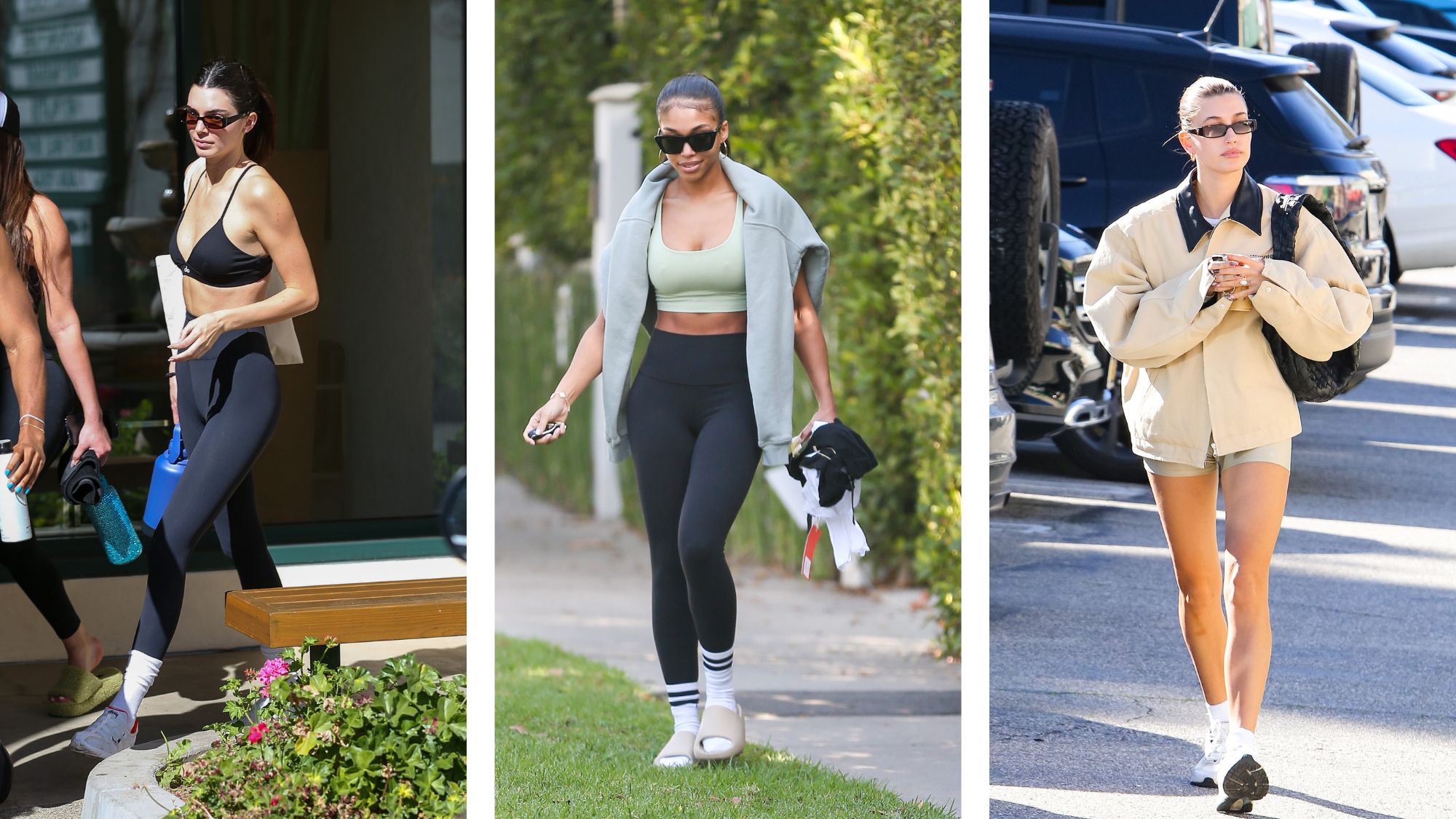It's the hottest workout of the year - so, is Pilates a form of strength training? Two top instructors explain
Hailey Bieber, Lori Harvey and Kendall Jenner are all fans.


It seems as though every wellness influencer under the sun is currently singing the praises of Pilates. With so much noise surrounding the workout, you might (understandably) be wondering: is Pilates a form of strength training?
The many claims about the positives of doing the popular sweat session aren’t unjust – the benefits of Pilates span improved flexibility, reduced risk of injury, and more. “Pilates improves your flexibility and posture, helping you increase your overall range of motion,” explains Jessie Blum, founder of Heartcore. “Additionally, regular Pilates sessions will balance and align your body, helping you prevent injuries and elevate any lower back pain you may experience.” Not just that, but this 2018 study published in Complementary Therapies in Medicine concluded that doing a Pilates workout could improve your mental health, too - as the study details, "following Pilates, percentage reductions in depressive symptoms ranged from 11 to 81%, 33% to 46% for anxiety, and 22.3% in mental fatigue."
So there’s no denying that Pilates is an excellent way to boost your wellbeing, but is it a form of strength training and is it any good for building both strength and muscle? If it is - would experts recommend swapping weight training sessions for Reformer classes?
Below, two experts share their take - on whether Pilates is a form of strength training and how to know which workout to opt for if you're on the fence. Keep scrolling, and do read our guides to Pilates for beginners, an instructor's pick of her go-to Pilates exercises, and the easiest 30-minute Pilates workouts to do from home.
Is Pilates strength training? Your guide
What is Pilates?
“Pilates is a fantastic way to enhance muscle tone and strength,” says Becky Robinson, PT at Nordic Balance. “It's not just about your core - it's a full-body workout.”
So - is it strength training? While Pilates could be considered a form of strength training as it promises to build muscle and strength, the trainer does stress that Pilates won’t facilitate strength gains akin to those you’d experience while lifting heavy weights, not to mention originates from a different founder.
“Pilates steadily builds strength, particularly in the core, back, and lower body, through controlled movements and bodyweight exercises,” Robinson explains. Traditional strength training, on the other hand, normally steadily builds strength in the area you target via the use of weighted compound exercises, like squats, lunges, and deadlifts.
Marie Claire Newsletter
Celebrity news, beauty, fashion advice, and fascinating features, delivered straight to your inbox!
That said, there are overlaps and similarities, too. Both workouts use resistance to build muscular strength, stability, and endurance.
Is Pilates a good substitute for weight training?
Ultimately, it depends on what your goal is. The reason weight training is so important, particularly as you age, is that in your thirties, you begin to lose muscle mass. As this benchmark study shows, strength training helps to reduce your risk of osteoporosis, preserves muscle mass and bone density, and reduces the risk of developing chronic diseases, such as heart disease, too.
If your goal is purely to gain strength, Pilates alone is probably not the most efficient route, according to the current research. One Heliyon study, which weighed up whether Pilates is better than other exercises for building strength, concluded that although Pilates can be helpful for increasing muscle strength when compared to no activity, the increase is not greater than compared with other types of exercise, such as weight lifting. In short: if you want to build muscle and increase your strength, you’re probably going to want to lift heavy.
That doesn’t mean you have to ditch Pilates altogether, though. “If you're aiming for substantial muscle growth, why not blend the two for the best of both worlds,” says Robinson. “Pilates is brilliant for core stability, flexibility, and endurance, while weight training excels in building muscle bulk and raw strength. Combining them can lead to a well-rounded strength profile, improving both endurance and power.”
In order to build strength, you need to be practising progressive overload – the principle which describes gradually making your training more challenging by adding load or reps over time. This is easier to navigate with weight training because there’s so much scope for increasing the weight.
There are still ways to make Pilates exercises more challenging, though. If you are using a Reformer, Blum advises that you can increase the intensity of your movements by adding more springs for additional resistance, or use heavier dumbbells. “On the mat, hand and ankle weights can be used with certain movements to increase the intensity, as well as heavier dumbbells.”
5 instructor-recommended Pilates exercises for building strength
1. Crazy monkey
Why? This move is great for targeting your abs, obliques, and upper body, shares the expert.
How to? "In a straight arm plank, lift one leg off the ground, exhale as you draw the leg sideways forward, keeping your upper body stable, head in line with your neck, and inhale as you extend the leg back," Blum says. Then, repeat on the other side.
How long? Aim for ten to twelve reps, three times.
2. Reverse bungee
Why? This move is one of the best you can do to target and build your glutes.
How to: "Lay on your back, draw your feet in line with your hips, stabilise through your upper back and shoulders," Blum explains. "Lift your hips, keeping your lower ribs 'closed'. Transfer your weight onto one leg, opposite leg lifts to the sky. Inhale as you drop your hips halfway, exhale as you lift. Focus on the connection between your heel and your glute."
How long? Aim for ten to twelve reps, three times.
3. Frendulum
Why? Looking for moves to strengthen your abs, obliques, and glutes - in other words, a full body workout? This one's for you.
How to: Come into tabletop position, and extend one leg out long behind you, stabilising through your upper body and abdominals. "Exhale as you bend your knee towards your shoulder, inhale as you extend your leg back behind you," Blum instructs.
"Next time, keep your leg straight and exhale as you bring your leg in line with your hip. Inhale as you extend your leg back behind you. Alternate between these two leg movements and repeat on both sides."
How long? Aim for ten to twelve reps, three times.
4. Alternate single leg squat
Why? A lower-body-focused move, this Pilates exercise will build strength in your hips, thighs, and glutes.
How to: Come into a wide stance with your feet parallel. "Inhale as you bend one leg, keeping the opposite leg straight, and reach with your arms forward and upwards to lift your spine," Blum says.
"Exhale as you come back up again, arms come to your side. Change to the other side. Always keep your weight in your heels and your upper body lifted to activate your glutes."
How long? Aim for ten to twelve reps, three times.
5. Lunge with tricep kickback and bicep curl
Why? Last but by no means least, this full body move targets your glutes, hamstrings, and upper body.
How to: Standing with your hand weights in your hands, step one leg back. "Bend into your front knee and hinge your upper body to a 45-degree angle," Blum instructs. "Hold your lunge and take three tricep kickbacks.
"Keeping your front knee bent, bend your back knee and lift your chest to a 90-degree angle and take three bicep curls. Alternate between these two body positions whilst working into your standing leg." Repeat on the other side.
How long? Aim for ten to twelve reps, three times.
Shop MC UK's go-to workout kit now:

Specifically designed for working out, up your workout wardrobe with this soft-to-the-touch sports bra that will support you in all the right places. Plus, you know you're investing in a company doing good - BAM is climate-positive and a certified B Corp.

The Bala ankle and wrist weights went viral for a reason. Not only do they look great, but they help take your workout up a notch by adding extra weight.

Topping our guide to the best yoga mats is this super popular 5mm-thick mat that comes with a whole load of cushioning, visual alignment cues and moisture absorption. Put it this way: it’s a deliciously padded mat that you won't mind getting out of bed for.

These sweat-wicking Sweaty Betty leggings get our vote. They're breathable, quick-drying and super comfy - in other words, definitely up to the task.
Is Pilates strength training or cardio?
Good question. As above, Pilates is a strength-focused workout that utilises resistance to boost both muscle and endurance.
While Pilates is a great low impact and joint-friendly workout that can target lesser used muscle groups you don't normally use, traditional strength training, like weight lifting, targets your major muscle groups, including your chest, back, legs, shoulders, biceps, and triceps.

Abbi Henderson is a freelance journalist and social media editor who covers health, fitness, women’s sport and lifestyle for titles including Women's Health and Stylist, among others.
With a desire to help make healthcare, exercise and sport more accessible to women, she writes about everything from the realities of seeking medical support as a woman to those of being a female athlete fighting for equality.
When she’s not working, she’s drinking tea, going on seaside walks, lifting weights, watching football, and probably cooking something pasta-based.




